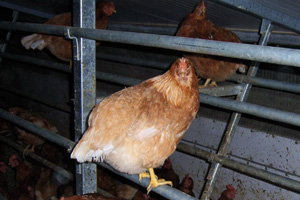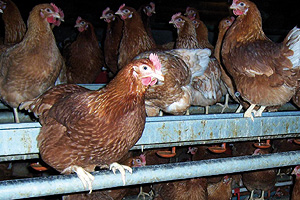Hens
Published on 30 January 2013 in Food, health and wellbeing
SRUC research confirmed that when laying hens are able to perch regularly it increases their leg strength and showed that hens unable to perch properly show signs of frustration and were more prone to being pecked by other hens. The work not only contributed to one of the first EU-wide laws governing how farm animals, including hens, are kept but also provided clear guidelines on the optimum perch design.

Key Challenges
In the early 1990s, SRUC began a research programme looking at perching in laying hens. At this time over 80% of hens on commercial units were be housed in cages and for those birds not housed in cages there was no requirement to provide an aerial (elevated) perch. This was a potential welfare problem because perching enables subordinate hens to avoid dominant birds, to escape unwanted feather pecking or aggression and gives all birds an opportunity to roost at night. Perching behaviour also increases leg bone strength, an advantage in hens that are skeletally weakened by continual egg laying. However, there were arguments over whether aerial perches caused keel bone fracture in laying hens. A perching system that maximised animal welfare and leg strength was needed, one that would benefit the entire poultry industry.
Key Benefits
SRUC’s research identified the optimum design for an aerial perch and contributed to one of the first EU-wide laws governing how farm animals, including hens, are kept. This directive affects the 200 million hens that are floor-housed in the EU (as opposed to those kept in cages).
The team researched the ideal perch design, assessing both height, angle and considering which materials would help the hen land safely (thus decreasing the likelihood of any injury). They also studied how perches could affect social behaviour and hierarchies in hens, as well as examining how crowded perches (often found in commercial systems) can influence the accuracy of hens landing on them.
The work not only contributed to one of the first EU-wide laws governing how farm animals, including hens, are kept but also provided clear guidelines on the optimum perch design.
The relationship between aerial perches and bone fracture in laying hens was studied, as this contentious issue (i.e. that aerial perches cause keel bone fracture) has led to various interpretations of what is permissible as a perch within the UK. Our work has shown that careful design of perches (i.e. not too high, and easy for hens to negotiate) does not increase the incidence of bone fracture in laying hens.
SRUC’s research contributed to the EC Directive 1999/74 and influenced the subsequent interpretation of that directive by the Scottish Government. The law means that the 200 million floor-housed hens in the EU now – in most cases - must have access to aerial perches.


Comments or Questions
Related Websites
Our Partners
This research was carried out by SRUC only.
Find Out More
Visit Dr Victoria Sandilands' SRUC Research Profile, http://www.sruc.ac.uk/vsandilandsAuthor
Dr Victoria Sandilands Vicky.Sandilands@sruc.ac.uk







